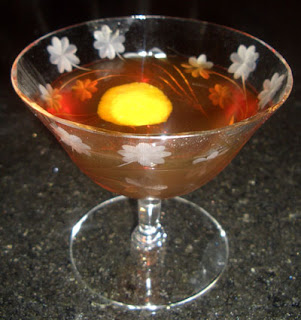
This month's
Mixology Monday theme, "Punch" (MxMo XLVII), was picked by Mike of
Hobson's Choice. Mike asked David Wondrich for some commentary on punch, and Dave replied, “The thing I like to keep in mind while making Punch is that it is, as the London Physician Nicholas Falck defined it in 1779, ‘an extemporary kind of wine.’ It is not, in other words, simply a large cocktail. Like wine, it should be balanced, not too pungent, not too strong, and preferably not decked out in all sorts of gaudy frippery like something participating in the retail sex trade.” And with that, Mike wanted to know what the crowd of Mixology Monday could come up with.
For inspiration, I opened up a copy of the 1869
Cooling Cups and Dainty Drinks which gave the following opening poem about punches:
Whene'er a bowl of punch we make,
Four striking opposites we take--
The strong, the small, the sharp, the sweet,
Together mixed, most kindly meet.
And when they happily unite,
The bowl is "fragrant with delight."
In the text, one punch grabbed me instantly for it was both an oddball and a tantalizing recipe. It did not fall into the popularized 5 part punch family which includes a citrus component, but does have the four parts laid out in the poem, and has more of a Caribbean than the classic English-India feel to it. The Trinidad Punch I picked was not the better known rum, lime, simple syrup, and Angostura Bitters recipe of the same name, but was described as:
Trinidad Punch - In 1 pint of rum digest 1 oz. chocolate, 1/2 stick vanilla; when well incorporated, strain; add 2 pints cocoa-nut milk. This punch can be used either as a cool cup, with ice, or hot."
To enact this punch, I scaled things down a little, and upon tasting the mix before it was chilled, it definitely needed some sweetening to smooth out the hot rum flavors and make it more drinkable. Perhaps the recipe relied on sweeter coconut milk than the one I was using, or a drier aesthetic prevailed. My recipe was as follows:
Trinidad Punch
• 6 1/2 oz Rum (Flor de Caña 4 Year Gold Rum)
• 3/4 Vanilla Bean (Tahitian)
• 13 1/2 oz Coconut Milk
• 1/2 oz Chocolate (Vivani 85% Cocao Dark Chocolate)
• 3 oz Simple Syrup (1:1)
Split the vanilla bean lengthwise and infuse in rum for 24 hours, then remove. Grate chocolate and add to coconut milk; heat while stirring until chocolate has dissolved. Combine infused rum and flavored coconut milk with simple syrup (to taste) and refrigerate. Serve in punch cups garnished with a half vanilla bean. Makes 4 servings.
Since I did not have the larger Bourbon vanilla beans in my spice collection, I utilized the smaller Tahitian varietal. Moreover, I opted to serve the punch cold but I could imagine that it would be quite delightful served hot.

The Trinidad Punch started with chocolate, vanilla, and rum notes on the nose. The rum and chocolate flavors were just heavenly together on the sip, and a delightful lingering chocolate and coconut taste was present on the swallow. One down side of serving this drink cold was the presence of a few small chunks of solidified coconut fat; a quick straining through a tea strainer would surely eliminate this issue. Other than that, I would definitely consider this recipe a win. Given the flavor profile, it was hard at first to consider it a punch as I have grown to know the classic genre to be, but it surely fulfills the strong, small, sharp, and sweet requirements, as well as Wondrich's most colorful description above.
So thanks to Mike for hosting this Mixology Monday and cheers to the rest of the participants this time around!




 3/4 oz Bourbon
3/4 oz Bourbon


 This month's
This month's 
 1 1/2 oz Brandy
1 1/2 oz Brandy







 1/5 Angostura Bitters (1/4 oz)
1/5 Angostura Bitters (1/4 oz)
 1 oz Dry Gin (Bombay Dry)
1 oz Dry Gin (Bombay Dry)




 1 oz Jamaican Rum (Coruba)
1 oz Jamaican Rum (Coruba)






 The 2017 collection of 855 drink recipes, bartender tributes, and essays on hospitality from CocktailVirgin's Frederic Yarm. Available at
The 2017 collection of 855 drink recipes, bartender tributes, and essays on hospitality from CocktailVirgin's Frederic Yarm. Available at  The 2012 collection of 505 drink recipes, techniques, and Boston bar recommendations from Frederic Yarm. Available at
The 2012 collection of 505 drink recipes, techniques, and Boston bar recommendations from Frederic Yarm. Available at 




